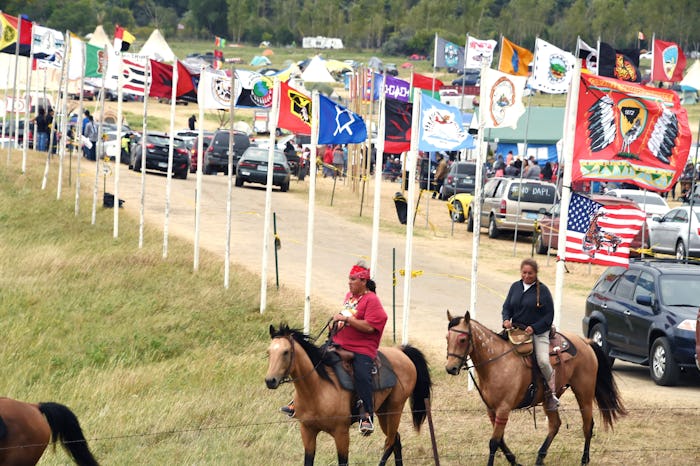News

Standing Rock Sioux Protests: What You Should Know To Understand The Situation
Tensions are still high in North Dakota this week. The Standing Rock Sioux protests have sort of taken on a life of their own recently, as many groups are converging on the site to protest the construction of the pipeline, a $3.7 billion project that is meant to transport over 470,000 barrels of crude oil across 1,172 miles from North Dakota to Iowa. And while many have been checking in on Facebook (a gesture of solidarity that some activists have warned against) and spreading the word about the clashes between law enforcement and protesters, there's a lot out there that's still not understood about the roots of the protest itself.
The Standing Rock Sioux tribe has been protesting the pipeline since 2014. Although the pipeline doesn't go directly through the tribe's reservation, it cuts across land that plays home to multiple sacred burial sites and prayer areas. For the Standing Rock Sioux, it's as much about their heritage as it is the environment. The pipeline, also known as DAPL on social media, runs into Lake Oahe, which the tribe holds sacred, and it could potentially damage the Missouri River, which is a primary water supply for the tribe.
In the past few weeks, hundreds of protestors, including celebrities like Shailene Woodley and Mark Ruffalo, have been camping out at the site and they claim they want to stay through the winter. To cover the costs associated with the protests, North Dakota officials have asked for $4 million, which is expected to be signed off on Tuesday.
But the influx of out-of-state protestors might be blurring some of the key issues surrounding the construction of the pipeline and possibly getting in the way of securing a victory for the Standing Rock tribe.
It's an environmental issue, for sure. Pipelines break and can affect the water and the land surrounding it. But one of the points of contention between the Standing Rock tribe and the federal government, which is overseeing the construction, is that the tribe wasn't involved enough in the planning process.
Earlier this year, the Standing Rock Sioux tribe sued the U.S. Army Corps of Engineers for not abiding by the National Historic Preservation Act, which required federal agencies to notify the tribe sooner than they did before construction. A D.C. Circuit Court denied the tribe an injunction in early October, but construction is still halted in the area by order of the Department of Justice, the Department of the Army, and the Department of the Interior.
On Oct. 19, the agencies issued a joint statement saying, "the Army continues to review issues raised by the Standing Rock Sioux Tribe and other Tribal nations and their members and hopes to conclude its ongoing review soon." They also wrote that, "in the interim, the Army will not authorize constructing the Dakota Access Pipeline on Corps land bordering or under Lake Oahe. We repeat our request that the pipeline company voluntarily pause all construction activity within 20 miles east or west of Lake Oahe.”
So for now, the sacred areas are safe, but possibly not for long, which is why protestors have sprung into action. Many of the protestors claim that law enforcement has been using aggressive tactics to break them up and residents of the area are rightfully worried about violence and other problems that can occur when large groups of organized and unorganized protestors gather. There have been over a hundred arrests and tensions seem to be escalating. Standing Rock tribe members, along with members of over 300 tribal nations, have been protesting and camping at the site since April.
"The protesters are not being peaceful or prayerful," Cass County Sheriff Paul Laney claimed in statement to ABC News. "Law enforcement has been very methodical in moving ahead slowly as to not escalate the situation. However, the protesters are using very dangerous means to slow us down. Their aggressive tactics include using horses, fire and trying to flank us with horses and people."
It seems as though the situation is evolving from being about protecting the Standing Rock Sioux tribe's land, heritage, and civil rights, to being more about having something to protest and fighting the authorities over abuse of the environment. Instead of helping the cause, some protestors could be distracting from the real issues at hand, leaving the Standing Rock Sioux to deal with the aftermath, whatever that turns out to be.
For now, at least the situation is getting attention. Unfortunately, the heart of the matter — protecting Native culture and grounds — seems to be lost, for the time being.